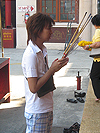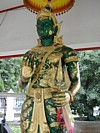|
I
Chinga (易经)
Chinese monk and writer who
visited Chaiya in the late 7th century and testified to its religious
and cultural sophistication.

icon
An image, symbol or statue of a
sacred or religious object or subject, as well as the main votive image
in a temple. Often confused with the Greek icon or ikon.

idgah
An open area to accommodate
prayers during Muslim festivals, usually placed to the West of a town.

Idsuan (อิศวร)
A Thai name for Shiva and
Ishana.

imam
1. Arabic. Worldly and
spiritual leader in the Muslim theocratic system. 2. Arabic. Muslim
religious leader and head of a mosque, the minister in ritual prayers.
3. Arabic. Term used by the Shiite Muslims to denote the descendants of
the prophet, who they consider to be the true rulers of the Muslim
community.

incarnation
'Embodiment'. The
personification or representation of a superior being, deity or spirit
of a god in another form. In Hinduism usually applied to the guises or
transformations of Vishnu. See also avatara.

incense stick
Name for both a small wooden
stick coated with a tick layer of incense and a solid stick completely
made of incense material, without a supporting core. There are many
different colours and they are made from a wide variety of materials,
both natural and artificial. They are often used at religious ceremonies
and spiritual purification rites, in places of worship of different
religions. There are several kinds, such as very thick and large incense
sticks used at special occasions like funerals, but the most commonly
used incense sticks in Thailand are small joss sticks, cored incense for
religious practice that consist of a light coloured incense on a usually
purple or red wooden stick of about 20-30 cm long. Thai Theravada
Buddhists habitually burn three incense sticks at a time, symbolic for
the Triratana, the three objects of veneration for Buddhists, i.e. the
Buddha, the Dhamma, and the Sangha, whereas Thai-Chinese Buddhists
belonging to the Hinayana sect tend to burn a whole bunch of incense
sticks at the same time. It is believed that when offering food, the
scent of the incense takes the food up to heaven as long as the joss
stick burns. Once the incense is burned up the food is taken away, often
for own consumption. Due to the large amount of incense sticks burning
simultaneously, especially in Chinese temples and on auspicious days
when large crowds of people gather to make merit, the incense sticks are
discarded before they are burned up completely and burned in gong de or
joss ovens, in order to make place for newly arrived worshippers as well
as to avoid suffocation in badly ventilated locations where breathing
may become difficult due to high emissions of carbon monoxide and
concentration of smoke. If they are not discarded they are sometimes
left and piled up on top of each other to form a tower of sticks.
Incense sticks are also used for other than religious purposes, e.g.
against mosquitoes or to enhance the smell in ones home. Joss stick are
usually burned in a special vessel called an incense burner, known in
Thai as kratahng toob, or in a censer called takan used when burning
incense such as cones for one, whereas incense sticks are called toob.
Before burning incense sticks the person offering them will first make a
vow called athitahn, in which the hands are brought together above the
head, making a wai.


Indra (इन्द्र)
Sanskrit. 'Possessing a drop
[of rain]', composed of indu, meaning 'drop' and ra, meaning
'possessing'. Vedic god of the heavens, weather and war, king of the
gods and ruler of the Tavatimsa heaven, a place on the summit of the
mythical Mt. Meru. He has a green complexion and may carry a
thunderbolt, disc, elephant goad, sword, a trihsoon (trident) or an axe.
Being the god of heavens and weather, his bow (dhanus) is a rainbow, in
Sanskrit called Indradhanus and in Thai known as Inthanu, meaning the
bow of Indra. In Buddhist iconography he is frequently depicted as an
attendant of Buddha, along with Brahma. His mount is the elephant Erawan
or Airavata. In Hindu cosmology he is the lokapala of the East. His
status is considered equally important to that of Vishnu and Shiva. In
Thailand called Phra Intra.


Indrachit (इन्द्रजीत,
อินทรชิต)
Sanskrit-Thai. 'Conqueror of
Indra'. Son of Ravana (Totsakan) and one of the demons in the Ramakien,
who succeeds in deceiving the monkey-general Hanuman by disguising
himself as Indra. It is also Indrachit who shot the nagabaat or nagapasa
arrow, the arrow that changed into a naga and tied Rama and Lakshmana
down. However, when the Garuda, the archenemy of the nagas, accidentally
flew by, the naga from fear released Rama and Lakshmana.

Indradhanus (इन्द्रधनुस्)
Sanskrit. 'The bow (dhanus) of
Indra', i.e. a 'rainbow'. Indra is the Hindu god of heavens and weather,
hence his bow is a rainbow. In Thai Inthanu. See also rung.

Indrani (इन्द्राणी)
Sanskrit. Consort of the Hindu
god Indra.

Inthanu (อินทรธนู)
Thai. 'The bow of Indra', i.e.
a 'rainbow'. Indra is the Hindu god of heavens and weather, hence his
bow is a rainbow. It is derived from the Sanskrit term Indradhanus. See
also rung.

iryapatha
Sanskrit. The four positions of
the body in which the Buddha can be represented, according to existing
iconography, namely walking, standing, seated and reclining.

Isaan (อีสาน)
Thai name for Isana, Ishana,
Idsuan and Shiva, the lokapala or guardian of the Northeast. Also Phra
Isaan.

Ishana (ईशान)
Sanskrit. Guardian or lokapala
of the Northeast. Also a name for Shiva or Rudra. Also Isana, and in
Thai Idsuan or Phra Isaan.


Ishvara (ईश्वर)
Sanskrit. 'Lord'. A title given
to the Hindu god Shiva.

Islam (الإسلام)
Arabic. 'Surrender/submission
(to the will of God)'. The Muslim religion based on the belief in one
supreme God (Allah in Arabic) and on the teachings of Muhammad, his
prophet who lived in the 7th century AD. The emphasis on a monotheistic
belief connects its heritage with that of Judaism and Christianity,
whose prophets Muslims recognize but believe that the Koran (recitation)
is the final revelation to humankind which fulfills and completes all
previous prophet's messages. Its five precepts are: profession of faith,
prayer, pilgrimage (Hadj), fasting and charity. The first of these five
pillars of Islam is called Shahada and states that 'there is no God but
Allah and Muhammad is the Messenger of God'. This proclamation is
recited whenever Muslims perform their five obligatory daily prayers.
The Islamic house of prayer is called mosque or masyid, literally a
'place of prostration'. These all have an arched niche in one of the
interior walls, called an mihrab and which indicates the qibla, the
direction of Mecca, their most important place of worship situated in
western Saudi Arabia and the birthplace of the prophet Muhammad. When
not praying in a mosque believers usually use a prayer rug, often with a
portrait Mecca. Islam was at first a religious ideology that would unite
the Arab world, but later, after allowing also non-Arabs it spread
rapidly in the 7th century to become the second largest religion in the
world with around 1,179 million believers.
 |